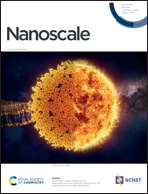Highly efficient and stable tandem luminescent solar concentrators based on carbon dots and CuInSe2−xSx/ZnS quantum dots†
Abstract
Semi-transparent large-area luminescent solar concentrators (LSCs) have been considered an essential part of zero-energy or low-energy consuming buildings in the future. Inorganic colloidal quantum dots (QDs) are promising candidates for LSCs due to the advantages of a tunable bandgap, engineered large Stokes shift, and relatively high photoluminescence (PL) quantum yield. However, LSCs that are fabricated using colloidal quantum dots exhibited an inferior stability under long-term illumination, demanding great efforts to explore the highly stable LSCs. Herein, we fabricated large-area (∼100 cm2) tandem LSCs based on highly stable carbon dots (CDs) and highly luminescent near-infrared emitting CuInSe2−xSx/ZnS (CuInSeS/ZnS) QDs. Coupled with a Si diode as a reference, the power conversion efficiency of the corresponding tandem (dimensions: 10 × 10 × 0.5 cm3) and single LSCs (dimensions: 10 × 10 × 0.3 cm3) based on CuInSeS/ZnS QDs under one sun illumination are 0.46% and 0.5%, respectively. For single CuInSeS/ZnS QD based LSCs at a low concentration (0.039 wt%), external and internal quantum efficiencies reach up to 2.87% and 36.37%, respectively. After UV illumination for 8 h, bottom LSCs based on CuInSeS/ZnS QDs retain 93.22% of the initial PL emission, which is higher than that of LSCs (∼80%) without the CD protection. The highly efficient and stable tandem LSCs employing green CDs and NIR CuInSeS/ZnS QDs as PL emitters pave the way for the realization of large area building-integrated photovoltaic (BIPV) devices.



 Please wait while we load your content...
Please wait while we load your content...